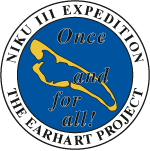 |
|
|
|
|
|
|
|
|
|
|
|
||
|
|
|
||
March 31, 1996
| Project Report: The Niku III Preliminary Expedition |
 |
Project Report The Expedition Preliminary Findings Conclusions |
|
||||||||||||
| Volume 12 Number 1 March 31, 1996 |
||||||||||||
|
||||||||||||
| 1. | Pending new evidence, further on-the-ground search operations along the island’s northeastern windward shoreline are not warranted. | |||||||||||
| 2. | There is no doubt that the inhabitants of the village at Nikumaroro used aircraft parts and materials for local decorative and utilitarian purposes. The extent of this activity, the source or sources of the parts, and the specific period during which this activity took place are not well understood. Information available at this time indicates that this activity was limited rather than common; that all of the aircraft parts used can be traced to two distinct sources; and that little or no such acivity was taking place during the time covered by the resident British administrator Gerald B. Gallagher’s quarterly reports (October 1940 to March 1941). | |||||||||||
| 3. | It is known from the identification of part numbers that one of the source aircraft was a Consolidated B-24C or B-24D within a particular block of serial numbers encompassing some 1,653 individual aircraft. It is also known that no such airplane ever crashed at Nikumaroro. A “large four-engined” aircraft is reported to have crashed late in the war at Sydney Island (now Manra) some 200 miles to the east. This wreck is said to have been extensively used as a local source of metal for decorative objects. We know there was post-war traffic between Manra and Nikumaroro and former residents of Nikumaroro now living in the Solomon Islands identify the Manra wreck as the source of airplane material found on Nikumaroro. (See “Solomon Islands Expedition.”) | |||||||||||
| 4. | A significant number, possibly as many as half, of the aircraft-related artifacts found in the village are not consistent with a B-24 nor any other known World War II aircraft. They are, instead, entirely consistent with archival documents describing Amelia Earhart’s Lockheed Electra. The nature and condition of the components suggests that they were removed from a relatively intact aircraft which was on land and standing on its landing gear. | |||||||||||
| 5. | Clearly, additional archaeological survey work in the village is warranted. Recent comparison of historical photographs of the village with areas searched on the three TIGHAR expeditions has pointed up several relatively untouched and potentially fruitful sectors. | |||||||||||
| 6. | The question of where the aircraft was, or is, remains. Because the B-24 parts were clearly imported from elsewhere, it is certainly possible that the same is true of the Electra parts. However, the wealth of archival documentation which supports Nikumaroro as the most likely site of the Earhart flight’s end; the repeatedly corroborated anecdotal accounts which describe the discovery of the skeletons, clothing and shoes of man and a woman by the island’s first settlers; and the well-demonstrated ability of the island’s environment to conceal large objects for many years, mandate a thorough inspection of Nikumaroro’s remaining unsearched regions before giving serious consideration to an alternative hypothesis. | |||||||||||
|
|
||||||||||
|